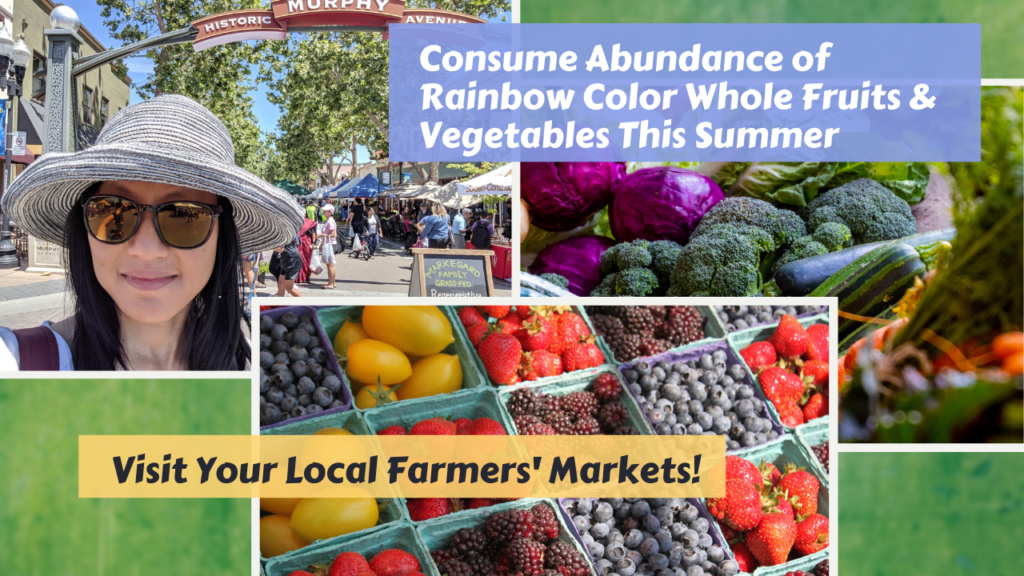Join our mailing list to receive the latest health tips and updates.
You have Successfully Subscribed!
Consume Abundance of Rainbow Color Whole Fruits & Vegetables This Summer

Summer is the time to take advantage of the abundance of harvest of a wide variety of fruits and vegetables.
Why not take this opportunity to consume plenty and a wide variety of fresh, rainbow color whole fruits and vegetables?
To find out more on what scientific research showed about the health benefits of consuming whole fruits and vegetables, why we should eat rainbow color fruits and vegetables, and how to maximize the nutritional value of our fruits/vegetables intake, please continue reading this article below.
Why Eating Fresh, Whole Fruits and Vegetables?
Whole fruits and vegetables are filled with phytonutrients that are rich in antioxidants, and anti-inflammatory and disease fighting properties. A diet rich in whole fruits and vegetables and generally a plant-rich diet has been shown by numerous scientific research to reduce the risk of many chronic diseases including heart disease, hypertension, diabetes, cancers, Alzheimer’s/dementia, obesity, etc.1–3
(For more information on diet and chronic diseases, please check out my previous articles here: http://www.simplyradiantliving.com/diet-and-chronic-diseases/.)
(For general guidelines of healthy eating, please see: Simple Guidelines for Healthy Eating.)
In addition to physical health benefits, research also showed that higher consumption of fruits and vegetables is also associated with improved mental and emotional health and wellbeing.1
Different fruits and vegetables constitute different compositions of bioactive phytonutrients and antioxidants, exerting a wide range of biological functions. Different plant pigments (in fruits, vegetables, legumes, whole grains, nuts, seeds) correspond to different phytonutrients or phytonutrient categories. For example, red->lycopene, orange->beta-carotene, yellow->hutein/zeaxanthin, green->chlorophyll and folate, purple->flavonoids, etc.1,2
Research has shown some general health benefits trend of different colors of fruits/vegetables, as summarized below:1
- Red foods: Anti-inflammatory, antioxidant, immune modulation.
- Orange foods: Antioxidant, hormone regulation and fertility support.
- Yellow foods: Antioxidant, gut and digestive health, blood sugar regulation.
- Green foods: Antioxidant, cardiovascular health.
- Blue-purple foods: Antioxidant, brain health, mental health.
Hence, it is important to consume a wide variety and rainbow color of fruits and vegetables and other whole plant foods.
Among various plant foods, those that are high in antioxidant content/density (not necessary variety) are herbs and spices, berries, nuts and seeds.2
Maximize the Nutritional Value of Your Fruits & Vegetables Intake
In order to maximize the nutritional value of the fruits and vegetables we eat, we should consume these foods as close to their natural forms as possible, i.e., whole and fresh.
Food storage (even in the fridge), transportation delay and processing (e.g. freezing, canning, drying, etc.) can reduce the nutrition content of fruits and vegetables.4,6 Also, the antioxidant content tends to be higher when fruits are at their ripest stage.5,7
Therefore, ideally, we should aim to shop for fruits and vegetables at the local farmers’ markets, where fruits and vegetables are typically harvested close to the time of sale and at their riper stage.
There are also other advantages of shopping at the local farmers’ market besides the higher nutritional value as discussed above. Some of these advantages are listed here:
- Enjoy the sunshine (and the beneficial vitamin D production) and fresh air outdoor.
- Shop for a wider variety of fruits and vegetables which may not be commonly found in grocery stores, and try out fruits/vegetables that you haven’t eaten before.
- Get in touch with the nature and learn which fruits and vegetables are in season and growing in their optimum conditions.
- Reduce carbon footprint associated with food transportation and distribution.
- Support local farmers.
While we may try to buy the freshest fruits and vegetables, certain cooking methods, in particular high heat cooking can degrade the nutrition content of foods. Steaming is generally a preferred cooking method, in terms of preserving nutrition content.8
Related Articles
Simple Guidelines for Healthy Eating
References
- Minich DM. A Review of the Science of Colorful, Plant-Based Food and Practical Strategies for “Eating the Rainbow” [published correction appears in J Nutr Metab. 2020 Nov 28;2020:5631762]. J Nutr Metab. 2019;2019:2125070. Published 2019 Jun 2. doi:10.1155/2019/2125070
- Carlsen MH, Halvorsen BL, Holte K, et al. The total antioxidant content of more than 3100 foods, beverages, spices, herbs and supplements used worldwide. Nutr J. 2010;9:3. Published 2010 Jan 22. doi:10.1186/1475-2891-9-3
- Jayedi A, Rashidy-Pour A, Parohan M, Zargar MS, Shab-Bidar S. Dietary Antioxidants, Circulating Antioxidant Concentrations, Total Antioxidant Capacity, and Risk of All-Cause Mortality: A Systematic Review and Dose-Response Meta-Analysis of Prospective Observational Studies. Adv Nutr. 2018;9(6):701-716. doi:10.1093/advances/nmy040
- Barrett D. Maximizing the Nutritional Value of Fruits & Vegetables. Food Technology. 2007;61(4).
- Hwang H, Kim YJ, Shin Y. Assessment of Physicochemical Quality, Antioxidant Content and Activity, and Inhibition of Cholinesterase between Unripe and Ripe Blueberry Fruit. Foods. 2020;9(6):690. Published 2020 May 26. doi:10.3390/foods9060690
- Kamiloglu S, Toydemir G, Boyacioglu D, Beekwilder J, Hall RD, Capanoglu E. A Review on the Effect of Drying on Antioxidant Potential of Fruits and Vegetables. Crit Rev Food Sci Nutr. 2016;56 Suppl 1:S110-S129. doi:10.1080/10408398.2015.1045969
- Sudha G, Priya MS, Shree RB, Vadivukkarasi S. Antioxidant activity of ripe and unripe pepino fruit (Solanum muricatum Aiton). J Food Sci. 2012;77(11):C1131-C1135. doi:10.1111/j.1750-3841.2012.02944.x
- Palermo M, Pellegrini N, Fogliano V. The effect of cooking on the phytochemical content of vegetables. J Sci Food Agric. 2014;94(6):1057-1070. doi:10.1002/jsfa.6478
